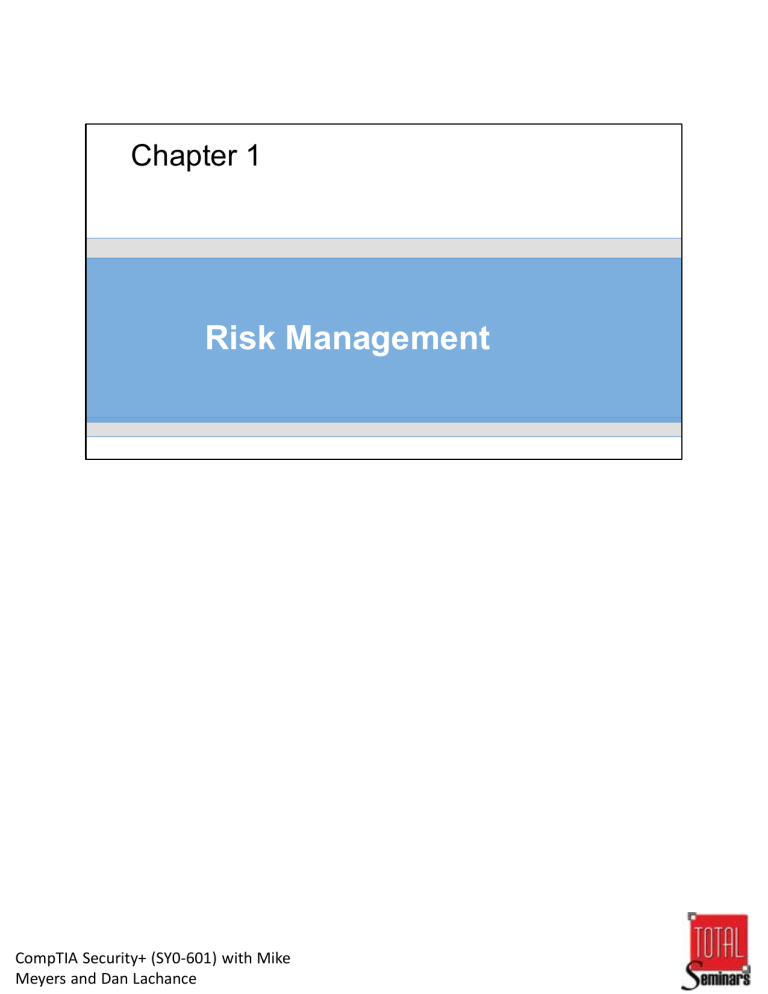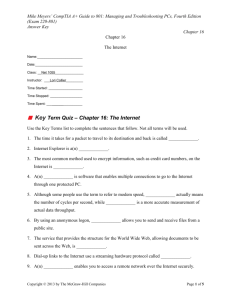
Chapter 1 Risk Management CompTIA Security+ (SY0-601) with Mike Meyers and Dan Lachance Episode 1.01 Episode title: Defining Risk Objective: 1.5 Explain different threat actors, vectors, and intelligence sources. CompTIA Security+ (SY0-601) with Mike Meyers and Dan Lachance Risk Management • Risk is the likelihood of a threat actor taking advantage of a vulnerability by using a threat against an IT asset CompTIA Security+ (SY0-601) with Mike Meyers and Dan Lachance Threat Actors • • • • • • • • • Hackers Hacktivists Script kiddies Insiders Competitors Shadow IT Criminal syndicates State actors Advanced persistent threat (APT) CompTIA Security+ (SY0-601) with Mike Meyers and Dan Lachance Quick Review • Risk is the likelihood of a threat actor taking advantage of a vulnerability by using a threat against an IT asset • An asset is any part of an IT infrastructure that has value • Likelihood is the probability of assets being damaged over time • A threat actor is anyone or anything with the motive and resources to attack another’s IT infrastructure • A vulnerability is a weakness in an asset • A threat is an action that a threat actor can use against a vulnerability to cause harm CompTIA Security+ (SY0-601) with Mike Meyers and Dan Lachance Episode 1.02 Episode title: Threats and Vulnerabilities Objective: 1.5 Explain different threat actors, vectors, and intelligence sources. CompTIA Security+ (SY0-601) with Mike Meyers and Dan Lachance Vulnerability and Threat • Vulnerability - A weakness inherent in an asset that leaves it open to a threat • Threat - An attack (exploit) that a malicious actor will use against an asset CompTIA Security+ (SY0-601) with Mike Meyers and Dan Lachance Threat Actors • Individuals or organizations who perpetrate attacks against vulnerabilities • Example: script kiddies CompTIA Security+ (SY0-601) with Mike Meyers and Dan Lachance Attack Vectors • Pathways to gain access to infrastructure - Weak configurations - Open firewall ports - Lack of user security awareness - Lack of multifactor authentication - Missing patches Equifax hack Stuxnet worm - Infected USB thumb drives CompTIA Security+ (SY0-601) with Mike Meyers and Dan Lachance Attack Vectors • Supply-chain attack - Manufacturers - Contractors - Implementers - Outsourced software development Right-to-audit clause CompTIA Security+ (SY0-601) with Mike Meyers and Dan Lachance Quick Review • Vulnerabilities are weaknesses of an asset in an IT system • Exploits take advantage of vulnerabilities • Threat actors are the sources of threats • Attack vectors are pathways to gain access to restricted systems CompTIA Security+ (SY0-601) with Mike Meyers and Dan Lachance Episode 1.03 Episode title: Threat Intelligence Objective: 1.5 Explain different threat actors, vectors, and intelligence sources. CompTIA Security+ (SY0-601) with Mike Meyers and Dan Lachance Threat Intelligence Sources • Facilitate risk management • Hardening can reduce incident response time • Provide cybersecurity insight - Adversary tactics, techniques, and procedures (TTP) - Threat maps Example: geographical representations of malware outbreaks CompTIA Security+ (SY0-601) with Mike Meyers and Dan Lachance Threat Intelligence Sources • Closed/proprietary • OSINT (open-source intelligence) - Government reports - Media - Academic papers CompTIA Security+ (SY0-601) with Mike Meyers and Dan Lachance Threat Intelligence Sources • Closed/proprietary • File/code repositories - Example: GitHub • Vulnerability databases - Common Vulnerabilities and Exposures (CVEs) CompTIA Security+ (SY0-601) with Mike Meyers and Dan Lachance Threat Intelligence Sources • Dark Web/dark net - Tor network, Tor Web browser - Encrypted anonymous connections - Not indexed by search engines - Tor encryption and anonymity Journalists Law enforcement Government informants CompTIA Security+ (SY0-601) with Mike Meyers and Dan Lachance Dark Web Animation CompTIA Security+ (SY0-601) with Mike Meyers and Dan Lachance Threat Intelligence Sharing • Automated Indicator Sharing (AIS) - Exchange of cybersecurity intelligence (CI) between entities • Structured Threat Information eXpression (STIX) - A form of AIS - Data exchange format for cybersecurity intelligence CompTIA Security+ (SY0-601) with Mike Meyers and Dan Lachance Threat Intelligence Sharing • Trusted Automated eXchange of Intelligence Information (TAXII) - Like RSS feed for threats - Consists of TAXII servers and clients - Real-time cyber intelligence feeds CompTIA Security+ (SY0-601) with Mike Meyers and Dan Lachance Quick Review • OSINT (open-source intelligence) refers to public cybersecurity intelligence sources • The Common Vulnerabilities and Exposures (CVE) database is an example of OSINT • The Dark Web is an encrypted and anonymized Internet access mechanism allowing access to unindexed content • STIX is a cybersecurity intelligence (CI) sharing format; TAXII exchanges CI CompTIA Security+ (SY0-601) with Mike Meyers and Dan Lachance Episode 1.04 Episode title: Risk Management Concepts Objective: 5.2 Explain the importance of applicable regulations, standards, or frameworks that impact organizational security posture. CompTIA Security+ (SY0-601) with Mike Meyers and Dan Lachance Risk Vector • Mission-critical IT systems - Payment processing - Human resources - Emergency • Sensitive data - Do we know what we have and where it is? • Third-party access CompTIA Security+ (SY0-601) with Mike Meyers and Dan Lachance Physical Risk Vectors • Access control vestibules (mantraps) • Server room access • Limit USB bootable devices CompTIA Security+ (SY0-601) with Mike Meyers and Dan Lachance Risk Management Frameworks (RMFs) • Center for Internet Security (CIS) - Cybersecurity best practices • NIST Risk Management Framework (RMF)/Cybersecurity Framework (CSF) - Cybersecurity risk management CompTIA Security+ (SY0-601) with Mike Meyers and Dan Lachance Risk Management Frameworks (RMFs) • International Organization for Standardization/International Electrotechnical Commission (ISO/IEC) - 27001/27002/27701/ 31000 IT system and information security CompTIA Security+ (SY0-601) with Mike Meyers and Dan Lachance Financial RMFs • Statement on Standards for Attestation Engagements System and Organization Controls (SSAE SOC 2) - Financial statement integrity - Internal controls - Type I and Type II CompTIA Security+ (SY0-601) with Mike Meyers and Dan Lachance RMFs • NIST Special Publication (SP) 800-30, Rev. 1 - “Guide for Conducting Risk Assessments“ - https://csrc.nist.gov/publications/detail/sp/800-30/rev1/final CompTIA Security+ (SY0-601) with Mike Meyers and Dan Lachance Data Privacy Regulations and Standards • General Data Protection Regulation (GDPR) - Protects EU citizens’ private data • Health Insurance Portability and Accountability Act (HIPAA) - Protect American patient medical information CompTIA Security+ (SY0-601) with Mike Meyers and Dan Lachance Data Privacy Regulations and Standards • Payment Card Industry Data Security Standard (PCI DSS) - Protect cardholder information - https://www.pcicomplianceguide.org/faq/ CompTIA Security+ (SY0-601) with Mike Meyers and Dan Lachance Types of Security Policies • Acceptable use policy (AUP) - E-mail, social media, Web browsing • Resource access policies - App or file access • Account policies - Account hardening CompTIA Security+ (SY0-601) with Mike Meyers and Dan Lachance Types of Security Policies • Data retention policies - Often dictated by regulations • Change control policies • Asset management policies CompTIA Security+ (SY0-601) with Mike Meyers and Dan Lachance Quick Review • Risk management frameworks (RMFs) provide guidance on identifying and managing risk • Security regulations and standards such as GDPR, HIPAA, and PCI DSS are designed to protect sensitive data • Organization security policies are designed to protect assets CompTIA Security+ (SY0-601) with Mike Meyers and Dan Lachance Episode 1.05 Episode title: Security Controls Objective: 5.1 Compare and contrast various types of controls. CompTIA Security+ (SY0-601) with Mike Meyers and Dan Lachance Security Controls • Solution that mitigates threat • Example: Malware scanner mitigates malware infections • Implemented differently based on platform/ vendor/user - Network infrastructure devices Switches, routers, firewalls CompTIA Security+ (SY0-601) with Mike Meyers and Dan Lachance Security Control Categories • Managerial/administrative - What should be done? - Employee background checks • Operational - How often must we do it? - Periodic review of security policies • Technical - How exactly will we do it? - Firewall rule configuration CompTIA Security+ (SY0-601) with Mike Meyers and Dan Lachance Security Control Types • Physical - Access control vestibule (mantrap) • Detective - Log analysis • Corrective - Patching known vulnerabilities CompTIA Security+ (SY0-601) with Mike Meyers and Dan Lachance Security Control Types • Deterrent - Device logon warning banners • Compensating - Network isolation for Internet of Things (IoT) devices • https://www.shodan.io/ CompTIA Security+ (SY0-601) with Mike Meyers and Dan Lachance Cloud Security Control Documents • Cloud Security Alliance (CSA) - Cloud Controls Matrix (CCM) CompTIA Security+ (SY0-601) with Mike Meyers and Dan Lachance Security Control Documents • Payment Card Industry Data Security Standard (PCI DSS) - Security controls must be in place to be compliant CompTIA Security+ (SY0-601) with Mike Meyers and Dan Lachance Risk Example • Risk - Theft of online banking credentials • Attack vector - Spoofed e-mail message with link to spoofed Web site tricking an end user • Mitigation through security controls - User security awareness - Antivirus software - Spam filters CompTIA Security+ (SY0-601) with Mike Meyers and Dan Lachance Quick Review • Security controls mitigate specific threats • Managerial security controls include administrative functions such as background checks • Operational security controls include policy reviews • Technical controls relate to specific IT security solutions • Security control types include physical, detective, corrective, preventive, deterrent, and compensating CompTIA Security+ (SY0-601) with Mike Meyers and Dan Lachance Episode 1.06 Episode title: Risk Assessments and Treatments Objective: 5.4 Summarize risk management processes and concepts. CompTIA Security+ (SY0-601) with Mike Meyers and Dan Lachance Risk Assessment • Prioritization of threats against assets and determining what to do about it • Applicable to - Entire organization - A single project or department • Targets - Servers Legacy systems Intellectual property (IP) Software licensing CompTIA Security+ (SY0-601) with Mike Meyers and Dan Lachance Risk Assessment Process • Risk awareness - Cybersecurity intelligence sources • Evaluate security controls - Inherent (current) and residual risk • Implement security controls • Periodic review CompTIA Security+ (SY0-601) with Mike Meyers and Dan Lachance Risk Types • Environmental - Flood, hurricane • Person-made - Riots, terrorism, sabotage • Internal - Malicious insider, malware infections • External - Distributed denial of service (DDoS) CompTIA Security+ (SY0-601) with Mike Meyers and Dan Lachance Risk Treatments • Mitigation/reduction - Security controls are proactively put in place before undertaking the risk • Transference/sharing - Some risk is transferred to a third party in exchange for payment - Example: cybersecurity insurance CompTIA Security+ (SY0-601) with Mike Meyers and Dan Lachance Risk Treatments • Avoidance - Avoid an activity because the risks outweigh potential gains • Acceptance - The current level of risk is acceptable - The risk falls within the organization's risk appetite CompTIA Security+ (SY0-601) with Mike Meyers and Dan Lachance Quick Review • A risk assessment strives to determine the likelihood and impact of threats • Risk types include environmental, personmade, internal, and external • Risk treatments (management) include acceptance, mitigation, transference, and avoidance CompTIA Security+ (SY0-601) with Mike Meyers and Dan Lachance Episode 1.07 Episode title: Quantitative Risk Assessments Objective: 5.4 Summarize risk management processes and concepts. CompTIA Security+ (SY0-601) with Mike Meyers and Dan Lachance Quantitative Risk Assessment • Based on numeric values • Asset value (AV) • Exposure factor (EF) - Percentage of asset value loss when negative incident occurs CompTIA Security+ (SY0-601) with Mike Meyers and Dan Lachance Single Loss Expectancy (SLE) • How much loss is experienced during one negative incident? • Multiply asset value (AV) by the exposure factor (EF) CompTIA Security+ (SY0-601) with Mike Meyers and Dan Lachance Single Loss Expectancy (SLE) • Asset value (AV) = $24,000 • Exposure factor (EF) = 12.5% • $24,000 (AV) X 0.125 (EF) = $3,000 (SLE) CompTIA Security+ (SY0-601) with Mike Meyers and Dan Lachance CompTIA Security+ (SY0-601) with Mike Meyers and Dan Lachance Quantitative Risk Assessment • Annualized rate of occurrence (ARO) - Expected number of yearly occurrences - Example: 2-3 times per year • Annualized loss expectancy (ALE) - Total yearly cost of bad things happening - ALE = SLE X ARO CompTIA Security+ (SY0-601) with Mike Meyers and Dan Lachance Annualized Loss Expectancy (ALE) • ALE = single loss expectancy (SLE) x annualized rate of occurrence (ARO) • Eg: $2,500 x 2 = $5,000 • Spending less than $5,000 yearly to protect the asset is worthwhile CompTIA Security+ (SY0-601) with Mike Meyers and Dan Lachance CompTIA Security+ (SY0-601) with Mike Meyers and Dan Lachance Quick Review • The single loss expectancy (SLE) is calculated by multiplying the asset value (AV) by the exposure factor (EF) • The annualized loss expectancy (ALE) is calculated by multiplying the annualized rate of occurrence (ARO) by the SLE CompTIA Security+ (SY0-601) with Mike Meyers and Dan Lachance Episode 1.08 Episode title: Qualitative Risk Assessments Objective: 5.4 Summarize risk management processes and concepts. CompTIA Security+ (SY0-601) with Mike Meyers and Dan Lachance Qualitative Risk Assessment • Based on subjective opinions regarding: - Threat likelihood - Impact of realized threat • Threats are given a severity rating CompTIA Security+ (SY0-601) with Mike Meyers and Dan Lachance Risk Register • Organizations should have one (or more) • Centralized list of risks, severities, responsibilities, and mitigations • Generally considered qualitative - Example: severity or impact ratings - Occasionally includes hard numbers (%, $) CompTIA Security+ (SY0-601) with Mike Meyers and Dan Lachance Risk Register Example Risk # Date Title Likelihood Impact Severity Owner Mitigation 1 March 5 On-premises customer PII data exfiltration High Med High User1 Refer to IRP #425-1 2 June 3 Employees not attending security awareness training Med High High User2 Company-issued devices, VPN 3 March 6 Employees using BYOD smartphones Med Med Med User2 Company-issued devices, VPN CompTIA Security+ (SY0-601) with Mike Meyers and Dan Lachance Risk Heat Map High 2 Medium 3 1 Medium High Low Impact • Take risk severity levels and map visually by color Low Likelihood CompTIA Security+ (SY0-601) with Mike Meyers and Dan Lachance Risk Matrix • Table of risk details • Similar to a heat map but without colors CompTIA Security+ (SY0-601) with Mike Meyers and Dan Lachance Quick Review • A qualitative risk assessment is based on subjective risk severity levels • A risk register is an up-to-date centralized list of risks and their relative severities and mitigations • Risk heat maps and risk matrices are used to plot and chart risk severity levels CompTIA Security+ (SY0-601) with Mike Meyers and Dan Lachance Episode 1.09 Episode title: Business Impact Analysis Objective: 5.4 Summarize risk management processes and concepts. 5.5 Explain privacy and sensitive data concepts in relation to security. CompTIA Security+ (SY0-601) with Mike Meyers and Dan Lachance Business Impact Analysis (BIA) • Prioritize mission-critical processes - Payment processing systems - Customer/patient records • Assess risk - Identify sensitive data - Identify single points of failure - Identify security controls and compliance CompTIA Security+ (SY0-601) with Mike Meyers and Dan Lachance Business Impact • Financial - Fines - Loss of contracts • Reputation • Data loss - Breach notification - Escalation requirements - Exfiltration CompTIA Security+ (SY0-601) with Mike Meyers and Dan Lachance Failed Component Impact • Mean time between failures (MTBF) - Average time between repairable component failures - Software patching • Mean time to failure (MTTF) - Average time between NON-repairable component failures - Hard disks, switches, routers • Mean time to repair (MTTR) - Time required to repair a failed component CompTIA Security+ (SY0-601) with Mike Meyers and Dan Lachance Locating Critical Resources • Data discovery and classification - Where is our sensitive data? - Privacy threshold assessment (PTA) First step before implementing solutions related to sensitive data • Impact on sensitive data - Privacy impact assessment (PIA) - Regulatory compliance CompTIA Security+ (SY0-601) with Mike Meyers and Dan Lachance Business Impact • Recovery point objective (RPO) - Maximum tolerable amount of data loss - Directly related to backup frequency • Recovery time objective (RTO) - Maximum tolerable amount of downtime - Return systems and data to usable state CompTIA Security+ (SY0-601) with Mike Meyers and Dan Lachance Quick Review • A business impact analysis (BIA) identifies how negative incidents will impact business processes and sensitive data • MTBF, MTTF, and MTTR are related to the impact of failed components • The recovery time objective (RTO) defines the maximum tolerable amount of downtime • The recovery point objective (RPO) defines the maximum tolerable amount of data loss CompTIA Security+ (SY0-601) with Mike Meyers and Dan Lachance Episode 1.10 Episode title: Data Types and Roles Objective: 5.5 Explain privacy and sensitive data concepts in relation to security. CompTIA Security+ (SY0-601) with Mike Meyers and Dan Lachance Data Classification • Government/military classification - Top secret - Secret - Confidential CompTIA Security+ (SY0-601) with Mike Meyers and Dan Lachance Data Classification • Standard classification - PII (personally identifiable information) - PHI (protected health information) - Proprietary - Public/private - Critical - Financial CompTIA Security+ (SY0-601) with Mike Meyers and Dan Lachance Data Privacy Standards • Ensure data privacy and breach notification • Levy fines • Protect intellectual property (IP) • Example: HIPAA (Health Insurance Portability and Accountability Act) CompTIA Security+ (SY0-601) with Mike Meyers and Dan Lachance Data Privacy Standards • PCI DSS (Payment Card Industry Data Security Standard) - Cardholder information • GDPR (General Data Protection Regulation) - Protects EU citizens’ data regardless of location CompTIA Security+ (SY0-601) with Mike Meyers and Dan Lachance Data Classification Tools • Any method of applying metadata - Example: cloud resource tagging CompTIA Security+ (SY0-601) with Mike Meyers and Dan Lachance Data Roles and Responsibilities • Owner - Legal data owner - Set policies on how data will be managed • Controller - Ensure data complies with applicable regulations • Processor - Handles data in accordance with privacy guidelines • Custodian/steward - Responsible for managing data (permissions, backup) in alignment with data owner policies • Data privacy officer (DPO) - Ensures data privacy regulation compliance such as with GDPR CompTIA Security+ (SY0-601) with Mike Meyers and Dan Lachance Quick Review • Data classification assigns labels to data to facilitate management • Common data privacy standards include HIPAA, PCI DSS, and GDPR • Data owners determine data management policies • Data custodians apply data management policies CompTIA Security+ (SY0-601) with Mike Meyers and Dan Lachance Episode 1.11 Episode title: Security and the Information Life Cycle Objective: 5.5 Explain privacy and sensitive data concepts in relation to security. CompTIA Security+ (SY0-601) with Mike Meyers and Dan Lachance Information Life Cycle • Security involved at every phase • Data collection - Consent • Implementation depends on regulations/ standards CompTIA Security+ (SY0-601) with Mike Meyers and Dan Lachance Information Life Cycle Collect Archive/ delete Share CompTIA Security+ (SY0-601) with Mike Meyers and Dan Lachance Store Process Personally Identifiable Information (PII) • One or more pieces of sensitive information that can be traced back to an individual - Social security number - E-mail address - Credit card number - Home address - Web browser cookie containing sensitive session identifiers CompTIA Security+ (SY0-601) with Mike Meyers and Dan Lachance Protected Health Information (PHI) • One or more pieces of sensitive medical information that can be traced back to an individual - Health insurance plan number - Blood type - Patient medical ailments CompTIA Security+ (SY0-601) with Mike Meyers and Dan Lachance Privacy-Enhancing Technologies • Anonymization • The GDPR allows anonymized data collection and use without user consent • Anonymized data has limited marketing value CompTIA Security+ (SY0-601) with Mike Meyers and Dan Lachance Anonymization Techniques • Pseudo-anonymization - Replace PII with fake identifiers • Data minimization - Limit stored/retained sensitive data • Tokenization - A digital token authorizes access instead of the original credentials • Data masking - Hide sensitive data from unauthorized users - Masked out credit card number digits on a receipt CompTIA Security+ (SY0-601) with Mike Meyers and Dan Lachance Data Sovereignty • Location of data and laws that apply to it - Where did the data originate? - Where does the data reside? - Which laws/regulations apply to the data? CompTIA Security+ (SY0-601) with Mike Meyers and Dan Lachance Quick Review • The information life cycle includes data collection, storage, processing, sharing, and archiving then deletion • Sensitive data can be anonymized through pseudo-anonymization, data minimization, data masking, and tokenization • Data sovereignty refers to the origin and storage location of data related to applicable laws CompTIA Security+ (SY0-601) with Mike Meyers and Dan Lachance Episode 1.12 Episode title: Data Destruction Objective: 2.7 Explain the importance of physical security controls. CompTIA Security+ (SY0-601) with Mike Meyers and Dan Lachance Data Destruction • Paper, film, magnetic tape - Burning - Pulping - Shredding (pulverizing) CompTIA Security+ (SY0-601) with Mike Meyers and Dan Lachance Digital Data Destruction • Failed or decommissioned storage devices • Storage device end-of-life policies - Reuse? Donate? Destroy? - Update asset inventory CompTIA Security+ (SY0-601) with Mike Meyers and Dan Lachance Digital Media Sanitization • Data is still recoverable - Deleted files, repartitioned, or reformatted drives • Disk wiping tools - SSD and HD Multiple pass disk overwrites - HD only Degaussing CompTIA Security+ (SY0-601) with Mike Meyers and Dan Lachance Digital Media Sanitization • Cryptographic erasure - Destroy storage media decryption key - Self-encrypting drives (SEDs) CompTIA Security+ (SY0-601) with Mike Meyers and Dan Lachance Quick Review • Data sanitization ensures sensitive data cannot be recovered • Organizational policies define how physical and digital data is safely destroyed • Data sanitization methods include burning, shredding, cryptographic erasure, disk wiping tools, and degaussing CompTIA Security+ (SY0-601) with Mike Meyers and Dan Lachance Episode 1.13 Episode title: Personnel Risk and Policies Objective: 5.3 Explain the importance of policies to organizational security. CompTIA Security+ (SY0-601) with Mike Meyers and Dan Lachance Personnel Management Policies • Standard operating procedure (SOP) - Example: proper steps for sending sensitive data via email • Mandatory vacation, job rotation - Detection of irregularities • Separation of duties (multi-person control) - Reduce likelihood of internal fraud - Does not prevent collusion CompTIA Security+ (SY0-601) with Mike Meyers and Dan Lachance Employee/ Contractor Hiring • Social media analysis • Web search • Background check - Criminal record - Unpaid fines - Credit check - Interviews with friends, family, colleagues CompTIA Security+ (SY0-601) with Mike Meyers and Dan Lachance User Onboarding • Non-disclosure agreement (NDA) - Proprietary secrets, PII/PHI • Security policy awareness - User sign-off • User account and resource access • Issue security badge, smart card CompTIA Security+ (SY0-601) with Mike Meyers and Dan Lachance User Habits • Clean desk policies • Physical and digital document shredding - Mitigates dumpster diving, data recovery • Personally-owned devices - Mobile device management (MDM) - Bring your own device (BYOD) CompTIA Security+ (SY0-601) with Mike Meyers and Dan Lachance User Training • Ongoing, role-based • Computer-based training (CBT) • Gamification - Capture the flag contests • Phishing campaigns/ simulations - Lunch and learn - Can be part of a penetration test CompTIA Security+ (SY0-601) with Mike Meyers and Dan Lachance User Offboarding • Termination letter • Exit interview • Return of equipment • Knowledge transfer • Account disablement vs. deletion CompTIA Security+ (SY0-601) with Mike Meyers and Dan Lachance Quick Review • Securing personnel management can be implemented with job rotation, mandatory vacations, and separation of duties • Employee and contractor background checks help ensure trustworthiness • User onboarding occurs after hiring and includes training and account provisioning • Clean desk and secure data disposal policies reduce the risk of security breaches CompTIA Security+ (SY0-601) with Mike Meyers and Dan Lachance Episode 1.14 Episode title: Third-Party Risk Management Objective: 5.3 Explain the importance of policies to organizational security. CompTIA Security+ (SY0-601) with Mike Meyers and Dan Lachance Third-Party Risk Management • Measurement systems analysis (MSA) - Quality assurance CompTIA Security+ (SY0-601) with Mike Meyers and Dan Lachance Supply Chain Security Risks • Hardware and software vendors - End-of-service life (EOL, EOSL) means no more patches or support • Cloud service providers security compliance • Contractors - Data privacy notices • Company mergers and system linking • Software developers using third-party components CompTIA Security+ (SY0-601) with Mike Meyers and Dan Lachance Third-Party Risk Management • Data Loss Prevention (DLP) systems - Reduce intentional/ unintentional sensitive data exfiltration CompTIA Security+ (SY0-601) with Mike Meyers and Dan Lachance Quick Review • A measurement systems analysis (MSA) can identify supply chain improvements • Supply chain risks include unstable or insecure hardware, software, or contractors, or suppliers not meeting security standards • Sensitive data stored in the public cloud presents a third-party risk • The intentional/unintentional disclosure of sensitive data can be controlled with DLP CompTIA Security+ (SY0-601) with Mike Meyers and Dan Lachance Episode 1.15 Episode title: Agreement Types Objective: 5.3 Explain the importance of policies to organizational security. CompTIA Security+ (SY0-601) with Mike Meyers and Dan Lachance Agreement Types • Interconnection security agreement (ISA) - Legal review, regulatory compliance Linking companies, partners, agencies Vulnerability scan results Mandatory training/ certification Input from IT security professionals • Service level agreement (SLA) - Contractual document stating level of service - Guarantee service uptime - Consequences for not meeting requirements CompTIA Security+ (SY0-601) with Mike Meyers and Dan Lachance Agreement Types • Memorandum of understanding (MOU) - Broad terms of agreement between parties • Memorandum of agreement (MOA) - Detailed terms between parties • Business partnership agreement (BPA) - Legal document - Responsibilities, investment, decision-making • Non-disclosure agreement (NDA) - Prevent sensitive data disclosure to third parties CompTIA Security+ (SY0-601) with Mike Meyers and Dan Lachance Quick Review • Interconnection security agreements (ISAs) apply when connecting different entities together • Service level agreements (SLAs) detail expected service uptime from a provider • Memorandums of understanding (MOUs) state broad agreement terms between parties, memorandums of agreement (MOAs) are more detailed • Non-disclosure agreements (NDAs) prevent sensitive data disclosure to third parties CompTIA Security+ (SY0-601) with Mike Meyers and Dan Lachance





